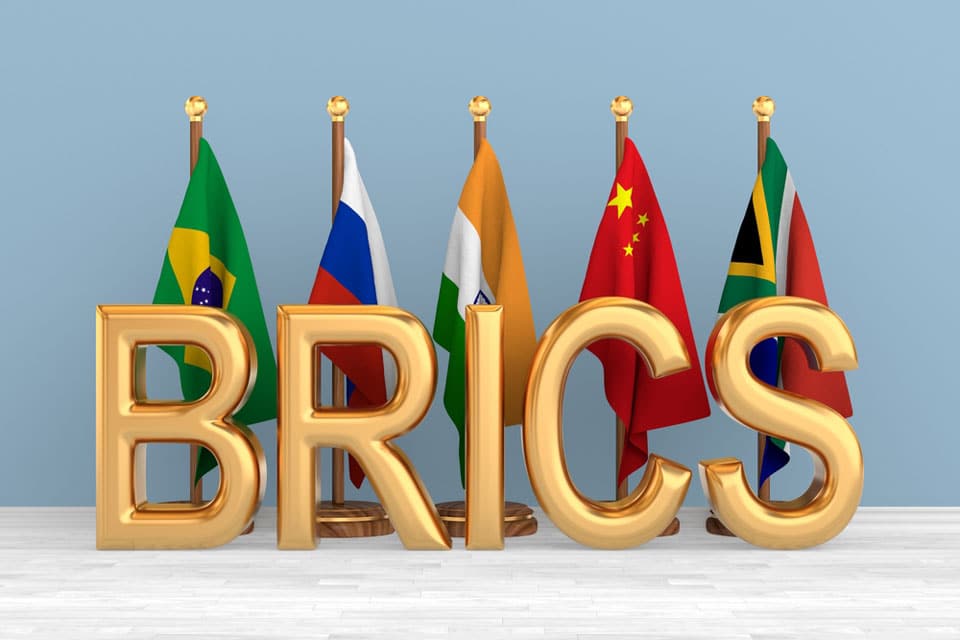Ranked: GDP of the BRICS countries (2000 to 2028)

The term BRICS refers to the five most prominent developing economies in the world since the beginning of the 21st century. In terms of GDP, China has the largest economy among the BRICS countries, standing at 18.56 trillion US dollars in 2024, while the other countries have a GDP below five trillion. Together, the BRICS countries have a GDP of over 27.24 trillion US dollars in 2024, almost the same as that of the United States (26.94 trillion US dollars).
In 2001, the term “BRIC” was coined by Jim O’Neill, a British economist at Goldman Sachs Investment Bank, to refer to the emerging economies of Brazil, Russia, India, and China. This term swiftly became popular with financial analysts and investors who were looking to take advantage of fast-growing markets. Since 2009, these countries have been holding annual summits, and in 2010, South Africa joined the group to form BRICS. Based on purchasing power parity (PPP), the BRICS nations surpassed the G7 nations in their share of the world’s total gross domestic product (GDP) in 2020. As of 2023, this difference has increased even further, with the BRICS now holding a total of 32 percent of the world’s GDP compared to the G7 countries’ 30 percent. We see this rising to 45% by 2040, more than double the weight of the Group of Seven major advanced economies.
China has been the largest economy in the BRICS bloc. With its rapid growth, it has now become the second-largest economy in the world, just behind the United States. China’s growth has outpaced the other BRICS countries by a considerable margin. For instance, in 2000, China’s GDP was less than double the size of Brazil’s, the second-largest BRICS economy at the time.
However, in 2021, China’s GDP will be almost six times larger than India’s, which is currently the second-largest BRICS economy. Over the years, the country with the second largest GDP has varied between Brazil, Russia, and India, owing to a range of factors. Since 2015, India has held this position, when the other two countries experienced a recession. India’s growth rate is on course to surpass China’s in the coming decade. South Africa, on the other hand, has consistently had the smallest economy in the BRICS bloc, and it ranks third in Africa. Despite this, it is included in this group because it has the most advanced and stable economy in Africa and holds strategic importance due to the continent’s financial potential in the coming years.
Gross domestic product (GDP) of the BRICS countries from 2000 to 2028 (in billion U.S. dollars)
| Yaer | China | India | Brazil | Russia | South Africa | Total |
|---|---|---|---|---|---|---|
| 2000 | 1,205.53 | 476.61 | 655.45 | 278.26 | 151.85 | 2,767.70 |
| 2001 | 1,333.65 | 493.95 | 559.98 | 328.48 | 135.53 | 2,851.59 |
| 2002 | 1,465.83 | 523.97 | 509.80 | 370.06 | 129.38 | 2,999.04 |
| 2003 | 1,656.96 | 618.36 | 558.23 | 461.52 | 197.02 | 3,492.09 |
| 2004 | 1,949.45 | 721.59 | 669.29 | 633.29 | 256.19 | 4,229.81 |
| 2005 | 2,290.02 | 834.22 | 891.63 | 817.72 | 288.75 | 5,122.34 |
| 2006 | 2,754.15 | 949.12 | 1,107.63 | 1,060.90 | 304.06 | 6,175.86 |
| 2007 | 3,555.66 | 1,238.70 | 1,397.11 | 1,393.42 | 332.65 | 7,917.54 |
| 2008 | 4,577.28 | 1,224.10 | 1,695.86 | 1,779.11 | 316.49 | 9,592.84 |
| 2009 | 5,088.99 | 1,365.37 | 1,669.20 | 1,307.93 | 331.18 | 9,762.67 |
| 2010 | 6,033.83 | 1,708.46 | 2,208.70 | 1,633.11 | 417.32 | 12,001.42 |
| 2011 | 7,492.21 | 1,823.05 | 2,614.03 | 2,046.62 | 458.71 | 14,434.62 |
| 2012 | 8,539.58 | 1,827.64 | 2,464.05 | 2,191.48 | 434.40 | 15,457.15 |
| 2013 | 9,624.93 | 1,856.72 | 2,471.72 | 2,288.43 | 400.88 | 16,642.68 |
| 2014 | 10,524.24 | 2,039.13 | 2,456.06 | 2,048.84 | 381.20 | 17,449.47 |
| 2015 | 11,113.51 | 2,103.59 | 1,800.05 | 1,356.70 | 346.66 | 16,720.51 |
| 2016 | 11,226.90 | 2,294.80 | 1,796.62 | 1,280.65 | 323.49 | 16,922.46 |
| 2017 | 12,265.33 | 2,651.47 | 2,063.52 | 1,575.14 | 381.32 | 18,936.78 |
| 2018 | 13,841.81 | 2,702.93 | 1,916.93 | 1,653.01 | 405.09 | 20,519.77 |
| 2019 | 14,340.60 | 2,835.61 | 1,873.29 | 1,695.72 | 389.24 | 21,134.46 |
| 2020 | 14,862.56 | 2,671.60 | 1,476.09 | 1,488.12 | 338.19 | 20,836.56 |
| 2021 | 17,759.31 | 3,150.31 | 1,649.63 | 1,836.63 | 420.01 | 24,815.89 |
| 2022 | 17,886.33 | 3,389.69 | 1,920.02 | 2,244.25 | 405.11 | 25,845.40 |
| 2023* | 17,700.90 | 3,732.22 | 2,126.81 | 1,862.47 | 380.91 | 25,803.31 |
| 2024* | 18,560.01 | 4,105.38 | 2,265.12 | 1,904.34 | 401.47 | 27,236.32 |
| 2025* | 19,781.70 | 4,511.85 | 2,362.16 | 1,927.98 | 417.95 | 29,001.64 |
| 2026 | 21,059.83 | 4,951.62 | 2,476.63 | 1,957.88 | 432.50 | 30,878.46 |
| 2027* | 22,291.05 | 5,427.39 | 2,632.21 | 1,969.79 | 445.46 | 32,765.90 |
| 2028* | 23,608.86 | 5,944.38 | 2,774.47 | 1,986.85 | 459.02 | 34,773.58 |
It has been forecasted that China’s GDP will surpass that of the United States by the end of the 2020s, making it the largest economy in the world. Additionally, India is also expected to overtake the U.S. around the mid-century mark. The BRICS group, which includes Brazil, Russia, India, China, and South Africa, is more than just an economic or trading bloc. In 2014, the group established its New Development Bank to invest in sustainable infrastructure and renewable energy worldwide. While the relationships between the members were often strained or of less importance in the 20th century, their current initiatives have given them a much greater international influence. The traditional great powers represented in the Group of Seven (G7) have seen their international power decline in recent decades, while BRICS countries have seen theirs grow, especially on a regional level. Today, the original BRIC countries combined with the G7 comprise 11 of the world’s 12 largest economies. However, analysts predict that they will move further up on this list in the coming decades.
Representatives from four countries adopted the acronym “BRIC” at the first BRIC summit held in the Russian city of Yekaterinburg in 2009. The BRICS is currently a major territorial and demographic bloc, covering almost one-third of the world’s land surface and comprising more than 40% of the global population. India and China, the world’s two most populous nations, have a combined population of nearly 3 billion people.
Have you read?
Timur Kulibaev: Top Kazakh Businessman and Philanthropist.
Communities can change the world.
How to stay motivated through challenging times.
How to ensure your business is scalable.
Why leaders need to build emotional resilience to better cope in challenging situations.
Bring the best of the CEOWORLD magazine's global journalism to audiences in the United States and around the world. - Add CEOWORLD magazine to your Google News feed.
Follow CEOWORLD magazine headlines on: Google News, LinkedIn, Twitter, and Facebook.
Copyright 2025 The CEOWORLD magazine. All rights reserved. This material (and any extract from it) must not be copied, redistributed or placed on any website, without CEOWORLD magazine' prior written consent. For media queries, please contact: info@ceoworld.biz








